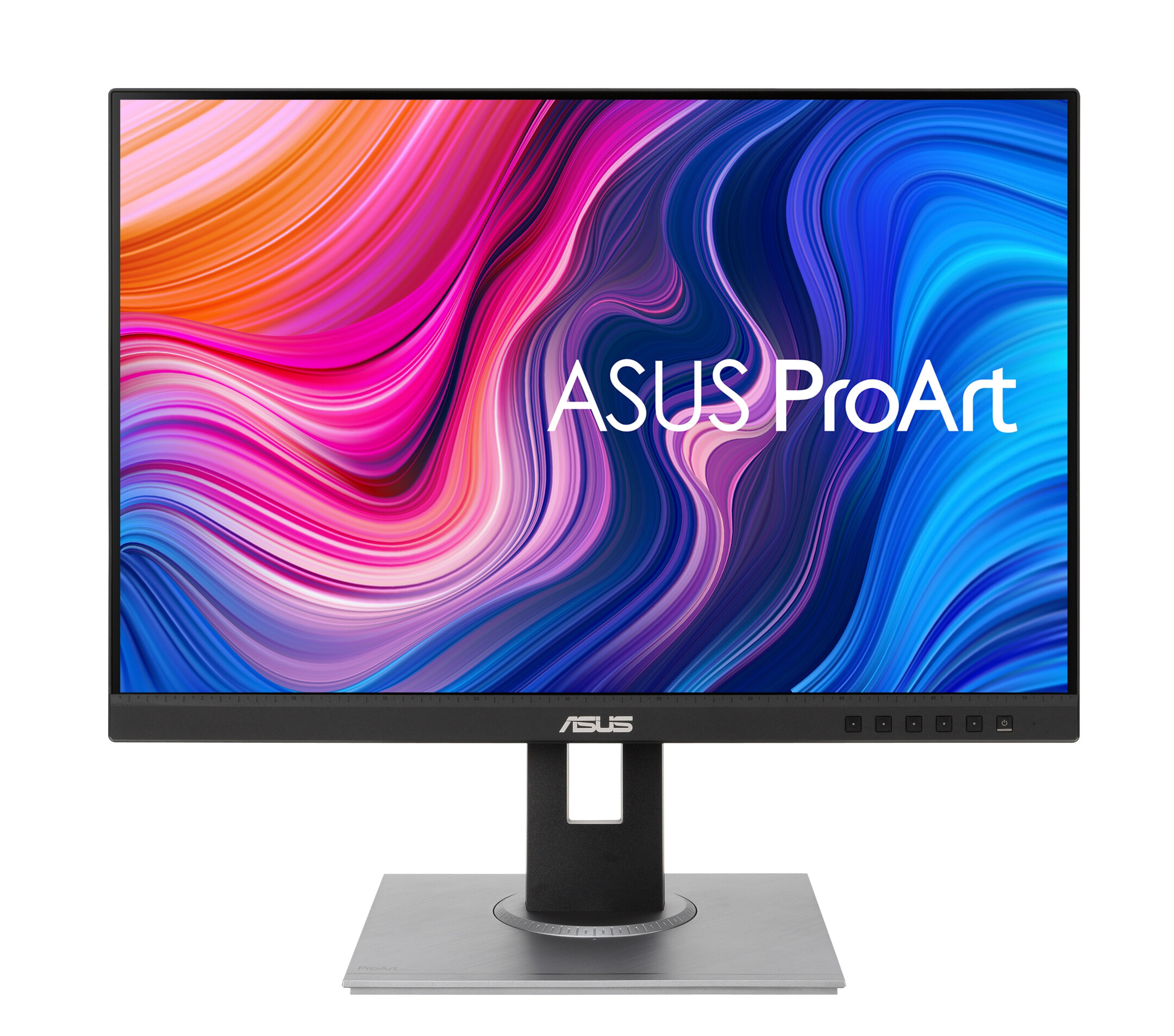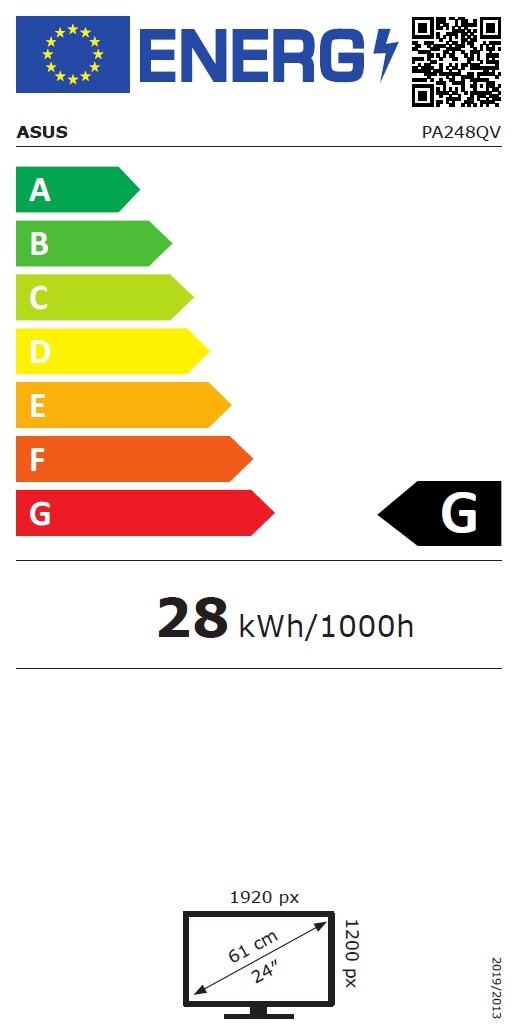























- Resolution 1920 x 1200 WUXGA
- Diagonal 24"
- Panel type IPS
- Refresh Rate 75Hz



Product information
61.21cm (24.1 inch) 16:10 WUXGA (1920 x 1200) IPS display with frameless design
International colour standard with wide colour gamut coverage of 100% sRGB and 100% Rec. 709
Calman verification with factory pre-calibrated settings for excellent Delta E colour accuracy
ASUS-exclusive ProArt Preset and ProArt Palette offer various customisable colour parameters and presets
75Hz refresh rate and Adaptive Sync technology (48~75Hz) for animated content with fast playback and no screen tearing
Extensive connectivity with DisplayPort, HDMI, D-Sub, audio input, headphone jack and four USB 3.0 ports for maximum flexibility
Support for VESA wall mounts and an ergonomic design with pan, tilt, swivel and height adjustment for comfortable use.
Incomparable colours. Boundless creativity
The ProArt PA248QV is a 61.21cm (24.1 inch) monitor designed to meet the needs of creative professionals, from photo and video editing to graphic design. The PA248QV ProArt display is factory pre-calibrated and Calman-verified to ensure outstanding Delta E colour accuracy
Bring out the true beauty of your images
The ProArt display delivers industry-standard colour space coverage of 100% sRGB and 100% Rec. 709 for brilliant, vivid reproduction that shows every detail of your photos clearly and faithfully.
High colour fidelity for extremely expressive shading
Thanks to the precise and lifelike colour reproduction, the user experiences particularly pure, expressive colour shades. ProArt monitors achieve Delta E colour accuracy.
Real colours, straight from the factory
Creative professionals rely on colour-accurate displays to make their work look exactly as intended. The ProArt PA248QV display is pre-calibrated and Calman-verified at the factory to ensure industry-leading Delta E colour accuracy Every ProArt display undergoes rigorous and extremely precise testing to ensure more consistent colour gradations. As a professional user, you can be assured of the highest colour accuracy when reproducing and creating content.
Image of the product
Fast colour matching
The ASUS-exclusive ProArt Preset feature offers multiple modes for quick colour space adjustment. Whether you're making colour corrections, editing videos or editing photos, you can easily switch between presets depending on your needs.
Personalised user experience when editing
ASUS ProArt Palette gives you the ability to customise your monitor with a variety of parameters, including hue, temperature and gamma settings - all easily accessible through intuitive on-screen menus. In addition, two-point greyscale sliders are provided for all six colours, allowing greater flexibility in colour adjustment than many competing monitors. ProArt Palette helps you produce quickly and consistently, and makes it easy to stay on top of colour management.
Versatile connectivity
The ProArt Display PA248QV offers extensive connectivity with DisplayPort 1.2, HDMI (v1.4), D-Sub interfaces and a built-in USB hub. So you can easily connect a wide range of devices and benefit from ultra-high transfer speeds with external storage - ideal for the rigours of content creation.
Full-size preview function
Save time and work more efficiently with ASUS QuickFit Virtual Scale. This clever feature superimposes a grid on the screen to align and preview documents at their actual size before printing.
ASUS Flicker Free Technology
ASUS Flicker Free Technology provides a more comfortable work and screen environment by reducing flicker on the screen. This minimises problems of eyestrain, headaches and fatigue, especially when you spend many hours at a time in front of the screen.
Technical data
| Name | Asus PA248QV 24" IPS Monitor, 1920 x 1200 WUXGA, 75Hz, 5ms |
|---|---|
| Article number | 1000013794 |
| GTIN/EAN | 4718017603393 |
| Manufacturer SKU | 90LM05K1-B01370 |
| EPREL ID | 387772 |
| Model name | PA248QV |
| Brand | Asus |
| Product Type | Monitor |
| Product Series | Asus PA Series |
| Technology | LCD |
| Panel type | IPS |
| backlight | LED |
| Resolution | 1920 x 1200 WUXGA |
| Diagonal | 24" |
| Aspect Ratio | 16:10 |
| Viewing angle - Horizontal | 178° |
| Viewing angle - Vertical | 178° |
| Contrast Ratio | 1,000 :1 |
| Max. Brightness | 300 cd/m² |
| Response time | 5ms |
| Refresh Rate | 75Hz |
| Support - VESA | 100 x 100 |
| Inputs | 1x Displayport , 1x HDMI , 1x VGA , 4x USB-A |
| Features | Flicker Free , Integrated speaker , tiltable |
| Product width | 53.3 cm |
| Product height | 36 cm |
| Product depth | 4.7 cm |
| Weight | 3.9 kg |
| Colour | Black |
| Power consumption (Annual) | 26 kW |
| EEK Spectrum | A to G |
| Energy efficency class | D |
| Delivery contents | Power cable |
| Condition | New |
| Warranty | 24 Month |
| Warranty type | Bringin service Service and support information |
Downloads
Product safety
| Person responsible for the EU |
|---|
| Ninepoint GmbH |
| Im Mediapark 8 |
| 50670 Köln |
| Germany |
| info@asus-shop.de |



